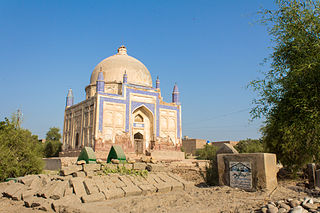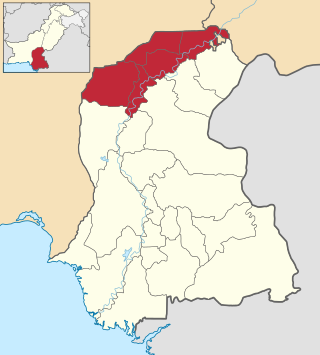Related Research Articles

Larkana District is a district of the Sindh province of Pakistan. Its largest city is Larkana, which sits on the banks of the Indus River. It is the home district of the influential Bhutto family.

Dadu District, is a district of Sindh Province, Pakistan. With headquarters in the city of Dadu, the district was created in 1931 by merging Kotri and Mahal Kohistan tehsils from Karachi District and Mehar, Khairpur Nathan Shah, Dadu, Johi and Sehwan tehsils from Larkana District. In 2004, several talukas in the south were split off to create the new Jamshoro District. Its boundary touches four districts of Sindh: Jamshoro, Naushahro Feroze, Shaheed Benazirabad and Kamber Shahdadkot.

Qambar Shahdadkot District is a district of Sindh, Pakistan, originally named after Shahdad Khan Khuhawar the official founder. District Qambar Shahdadkot, with headquarters at Qambar, was established on 13 December 2004.
Burfat, Bulfat or Bulfati is a Sindhi Sammat tribe, originally from the Lasbela and Kirthar (Kohistan) mountains of the Sindh province of Pakistan. Burfats are also found in Iran, Afghanistan and Oman.

Larkana Division is an administrative division of the Sindh Province of Pakistan. It was created in 1980 by bifurcation of Sukkur Division. In 2000 abolished by General Pervaiz Musharraf rule but Sindh government restored it again on 11 July 2011. CNIC code of Larkana Division is 43.
Mian Shahul Mouhammed Kalhoro: (Urdu) ميان شاهال محمد خان کلھوڑو : was the famous Ruler of the Kalhora Dynasty that ruled Sindh from 1620 to 1657. He was not only ruler but saint also after his elder brother death Main Elyas Muhammad Kalhoro he became the ruler of Sindh. He dug Ghar canel and irritated local lands when his influence increased he forcefully occupied lands as well, those lands belonged to Jalal Khan Abro, and Halar Khan Abro, on which they fought and he was killed in battle and later he buried on the upper bank of Ghar canel in village Dittal Abro, Qambar Shahdadkot District.
Mirokhan is one of the oldest tehsils situated in Qambar Shahdadkot District of Sindh province of Pakistan. It was established in 1915 and was considered to be the largest tehsil by area before the division of the Larkana district into Larkana and Qambar-Shahdadkot districts, its own division into Mirokhan and Sijawal tehsils.

Tomb paintings of Sindh are paintings found dispersed throughout tombs in the Sindh province of Pakistan.

Nai Gaj Dam is an embankment dam currently under construction on the Gaj River in the gorge area at the edge of Kirthar Mountains range at about 65 kilometres (40 mi) north-west of Dadu city in Dadu District, Sindh Province of Pakistan. When complete, its power station will have a 4.2 MW installed capacity. Consultant supervision by Techno Consult International (TCI) from Karachi, Pakistan.
Wahi Pandhi is a town near Johi, Dadu District of Sindh, Pakistan. A road from Wahi Pandhi leads to Gorakh Hill, a hill station in the Kirthar Mountains. An archaeological mound, locally famous as 'Kotero Daro', was explored by N. G. Majumdar during his explorations in Sindh from 1926 to 1929. The pottery of Amri and Harappan phase was explored at the mound.
Johi is a town in Dadu District, Hyderabad Division, Sindh province of Pakistan. It is located along Sindh's border with the Balochistan province. Johi town is also Taluka of Dadu District. A civil hospital is also in Johi.

Kachho or Kachho Desert is a semi desert area of Sindh, Pakistan. The Kachho is denoted from word of Sindhi language Kachh which stands for a lap or an armpit. The desert of Kachho is near the lap of the Kirthar Mountains range. History reveals that the area of the Kachho desert including Lake Manchar appeared in the result of flow of big branch of the Indus River in earliest times which had been flowing from Kashmore-Kandhkot to Luki Mountains. It is spread over two districts of Sindh Province, Dadu District and Qambar Shahdadkot District. Kachho is rich in fertile soil and forests. The Kachho is affluent in archaeological and historical sites. The several historic and prehistoric remains of civilizations can be observed herein Kachho desert from Neolithic and Bronze Age to British period. The people cultivate many kind of crops in Kachho. Kachho depends on rains. If it rains Kachho becomes prosperous because people cultivate lands and crops which boost the economy of the region including whole country. Due to rains the water level too increases and an environment also becomes pleasant. Mostly, the trees are big reason for heavy rains and good environment of the area. Numerous trees of Kachho desert have been cutting for sell since last many years. Thus, the environment is very pretentious and water level is dropped from 150 feet to 450 feet. The wells dug by people now became dry. The people of several villages of Kachho suffer for fresh drinking water.
Sijawal Junejo is a taluka of Qambar Shahdadkot District, division Larkana, Province of Sindh, Pakistan. It was established in 2004 when district Qambar Shahdadkot District was newly established. Sijawal Old Name was Sujawal Taluka. At the time of British Government Sujawal was taluka of District Shikarpur from approximately 1876 City was created by Hindus, After the partition the Hindus migrated to India, and then other castes, including Arian, Junejo & Magsi etc, started to arrive. Sijawal name was changed to Sijawal Junejo in year 2000 name was suggested by UC Nazim of that time.
The Ancient Graves are situated near Wahi Pandhi, Johi tehsil, Dadu District, Sindh, Pakistan, on the top of the hills near foothills of Kirthar Mountains Range. These columned graves are constructed with large slabs of stone on ground surface. The graves are open from northern and southern sides. The western and eastern sides of graves are constructed with stone slabs and also the graves are covered from upper side with slabs. The carpse were placed on ground surface in the graves. The bones can be observed in columned graves on ground surfaces in graves. Due to inscribed word "Behdin" on stone of one grave, it is believed that these ancient graves belonged to Zoroastrians. The word behdin means the good religion which is related to Zoroastrianism.

Johi Tehsil is an administrative subdivision (Tehsil) of Dadu District in Sindh province of Pakistan. Johi Town is its capital. Its area is 3,616 km². The tehsil, also known as Taluka, consists of 14 union councils, including Tando Rahim Khan (TRK) and Sawaro.
Shah Hasan, also spelled Shah Hassan, is a village and deh in Johi taluka of Dadu District, Sindh. It is located at the western end of Lake Manchar, about 24 miles west of Sehwan. As of 2017, Shah Hasan has a population of 2,597, in 481 households. It is the seat of a tappedar circle, which also includes the villages of Berah, Dhabhari, Dhori Kunri, Khanwah, Lohri, and Makhan Belo.
Zulfiqar Ali Kalhoro .(Sindhi: ڊاڪٽر ذوالفقار علي ڪلهوڙو) is a Pakistani anthropologist and research scholar and author. He works at the Pakistan Institute of Development Economics (PIDE) Islamabad.
References
- ↑ "Kīrthar Range | mountain region, Pakistan". Encyclopedia Britannica. Retrieved 2018-04-27.
- 1 2 3 "Ancient rock carvings of Sindh". DAWN.COM. 2011-05-08. Retrieved 2018-04-27.
- 1 2 "Ancient art of the Kirthar". www.thefridaytimes.com. Retrieved 2018-04-27.[ permanent dead link ]
- 1 2 3 4 "KARACHI: Rock carvings in Khirthar range". DAWN.COM. 2004-05-10. Retrieved 2018-04-27.
- 1 2 3 "Heritage: The writing on the wall by Zulfiqar Ali Kalhoro". www.thefridaytimes.com. Archived from the original on 2011-12-10. Retrieved 2018-04-27.
- ↑ Ali, Kalhoro, Zulfiqar (2014-07-01). "The Discovery of Rock Paintings in Sindh". Pakistan Historical Society. Journal of the Pakistan Historical Society. 62 (3).
{{cite journal}}: CS1 maint: multiple names: authors list (link) - ↑ Ali, Kalhoro, Zulfiqar (2013-07-01). "Buddhist Traditions in the Rock Art of Sindh, Pakistan". Journal of Asian Civilizations. 36 (1).
{{cite journal}}: CS1 maint: multiple names: authors list (link)